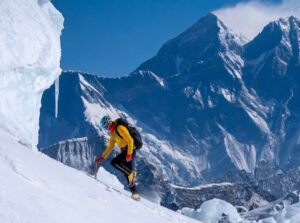April 1 came and went, and the situation around the new regulations banning independent trekkers from Nepal’s mountain areas remains a total mess. Nepal announced the measure without prior warning, days before it was due to kick in. Independent trekkers who had booked flights to Nepal months earlier had no idea what to expect. Now, it seems that Nepal had not really figured out how to implement the controversial new regulation.
As of today, no one seems to be preventing foreigners from traveling to Nepal and setting off down any trail. The measure states that all trekkers in Nepal must obtain a TIMS (Trekkers’ Information Management Systems) card, and such cards will be rejected for those not hiking with a guide. The guide’s name and affiliated company must appear on the form in order to get this TIMS card.

A TIMS card issued by Nepal Tourism Board
But what happens to those wandering both without a guide and a TIMS card? Supposedly, some checkpoints are scattered along the protected areas.
“However these have not opened since the pandemic years,” Roland Hunter of The Mountain Company told ExplorersWeb. “For the moment, no one is checking. But the NTB has confirmed it will reopen them soon.”
When exactly is “soon”?
On April 1, the Nepal Tourism Board stated that a foreign trekker found on designated trails without a guide or TIMS card faces a fine of about $90. To enhance motivation, officials dispensing the fine will keep 20 percent of it, the Kathmandu Post wrote.
It remains unclear whether fined trekkers can then just continue their trip or will have to turn back.
The Khumbu in rebellion
The NTB guidelines confirmed that the TIMS card and the services of a guide are required for trekkers and cyclists. This applies to every foreigner entering 44 trekking trails in Kangchenjunga, Makalu Barun, Rolwaling, Panchpokharai Bhairavkunda, Helambu, Langtang, Ganesh Himal-Ruby Valley, Manaslu, Annapurna, Mustang, Dhaulagiri, Dolpa, and Humla.
But apparently, not Everest. This new mandatory guide rule does not apply in the Khumbu. Khumbu authorities are apparently ready to go to court if necessary, to the NTB’s despair.
The Khumbu Pasang Lhamu Rural Municipality reiterated its stance one day after the central government implemented the rules. While recommended, it is not mandatory to hire a guide in the Everest region, says the Khumbu authority. Instead, since September 2022, trekkers must obtain a TREK Card, which is valid for both guided and unguided parties. See the official press release below.

Conflict with Khumbu
The Nepal Tourism Board reacted angrily to the Khumbu authorities’ perceived insubordination against what the NTB has tried to pitch as a safety measure. They cite the case of 54-year-old Hitoshi Ishiba of Japan, who was found dead last week beside the trail near Chola Pass, according to the Himal News Express. He had been missing for a week. Ishiba likely died from a hiatus hernia, says the outlet.
The Khumbu authorities have threatened to sue the central government over this issue, they told The Kathmandu Post. Under the powers granted by Nepal’s 2015 Constitution, which transformed a centralist state (a monarchy until 2006) into a sort of federal republic, individual regions acquired significant powers.
Meanwhile, trekkers are trying to gather last-minute information in order to decide where to trek or if they will go to Nepal at all. Some who have not already bought their plane tickets are considering alternative destinations, according to discussions on travel forums.

The trek to Kala Pattar, a safe area for guideless trekkers. Photo: Asian Trekking
Small businesses suffer
“I have had so many trekkers reach out to me in Kathmandu after reading your article,” Dawa Steven Sherpa of Asian Trekking told ExplorersWeb. “I confirmed the situation with the Khumbu, and people have gone on to trek there with no issues.”
As head of one of the biggest trekking and expedition outfitters in Nepal, Dawa Steven is also concerned about the impact the new measure can have on local entrepreneurs who cater to self-sufficient trekkers.
“The lodges and small businesses need independent trekkers more than big operators,” he said.
The controversial regulation is one of a number of strange, apparently improvised measures with which the NTB has surprised foreign visitors over the last few springs.
Two years ago, Nepal forbade climbers on 8,000m peaks to share photos of members in other expeditions. As expected, no one was sure about how to reinforce such a measure. No one was fined, and climbers happily shared their base camp and summit photos on social media, as they always had.
Equally futile were attempts to move Everest Base Camp to a lower location.






